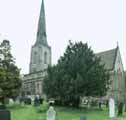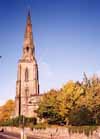 Gedling Gedling
All Hallows
History
The Domesday book includes two references to Gedling. Under the lands of Roger
de Buseli there is a manor held by Dunstan which has no reference to a church.
Under the lands of Goisfreid de Alselin there is another manor described in
a paragraph which starts: ‘In STOKE and Gedling…..’ and continues
to list
‘a Priest and a church’. Some commentators take this as meaning
that there were two manors in Gedling township and none in Stoke. This seems
doubtful as a map of 1609 shows that a church existed in Stoke as late as 1608.
The earliest records of clergy show that the benefice was divided into two
moieties. The first recorded Rectors were Peter de Lexington in c1230 for one
moiety, and William de Lexington in 1248 for the other. Lexington was another
name for Laxton where the de Alselins held the manor in Domesday.
On October 12th 1294 Thomas of Kirkcudbright was consecrated Bishop of Whithorn
(Scotland) in Gedling church by the Bishops of St Asaph and Carlisle. The reason
this happened in Gedling was that John de Haluchton, Rector of Gedling was
also the Bishop of Carlisle.
The patronage of one moiety was in the hands of the Bardolf family from which
it passed to the Crown and later to the Stanhopes. The other was in the hands
of the Prior of Shelford. On August 5th 1310
Royal licence was given to the Priory of Shelford to appropriate their moiety
and on November 12th in the same year a vicarage was ordained by Archbishop
Greenfield of York. The Archbishop ordered the Prior to provide a house to
the south of the church for the vicar and the house should have one hall, two
chambers, pantry, kitchen and a stable for two horses. At the same time the
Prior was to ‘repair and new build’ the chancel.
The Crown granted the rectory and patronage of the vicarage to Michael Stanhope
of Shelford on February 5th 1540/1 as part
of his purchase of the lands of the recently dissolved Shelford Priory.
The Protestation Returns of 1641 indicate that there were 204 men over the
age of 18 who agreed to ‘protest to maintain and defend the True Reformed
Protestant Religion’.
The last independent Vicar to be appointed was William Stokes, and when he
died in 1644/5 he was not replaced, so subsequent Rectors held both appointments.
On July 16th 1744 the rectory and vicarage were united.
Robert Thoroton describes only the stained glass in his visit of 1677.
In the north isle east window Azure three Cinquefoils Or, Bardolf quartering
Azure, a Lion Ramp. and flowers de Lis Or, Beaumont
There is also - Arg. on a Fesse double Cotifed Gules. three flowers of
Lis of the Field, Normanville, quartering Azure, a chevron between
three birds Arg.
Int the east window of the south isle - Azure, three cinquefoils Or, Bardolf
In the parsonage chamber window - Lord Crumwell with Tateshall quartering
Everingham.
Thoroton’s reference to the parsonage chamber indicates that some of
the former buildings to the north of the chancel were still in use then, presumably
as accommodation for the Vicar.
The Compton Census of 1676 revealed that there were 330 persons of age to
receive the Communion in the parish, one popish recusant and 7 dissenters who
absented thenselves from Communion ‘at such times as by law they are
required to Communicate’.
The responses to Archbishop Herring’s visitation questionnaire in 1743
by the Rector Richard Chenevix, indicated that in the Parish there were ‘100
odd Families with not above four or five Dissenters. And those Presbiterians’.
There was no Meeting House, Charity Schools, Alms-Houses, Hospitals nor ‘Lands
left for the Repair of ye Church;’
Chenevix resided in the Parish but had no Curate. He knew of none who came
to church who had not been Baptised but believed that there may be ‘some
few of a Competent Age, who have not been confirmed, not with standing al ye
Care I have taken to persuade em’ to it.’
He catechised in the Church every Sunday from Michaelmas to Easter and all
the year instructed children and young people ‘at Home’. But said
that there were some in the parish ‘whom it is not in my Power to persuade
to send their Children & Servants.’ He administered Communion at
Easter, Whit, Michaelmas and Christmas and ‘that Servants as well as
their Masters may have it in their Power to come each’ he administered
two Sundays running making eight times in each year. There were about 270 Communicants
with about 80 to 100 who usually received.
He gave warning of Communion the previous Sunday and did not require parishioners
to send in their names because he knew them all. He had never refused the Sacrament
to anyone.
When John Throsby visited the church in 1795 he remarked on the continued
use of the two stone coffins and included in his additions to Thoroton a sketch
of the lid of the one in the chancel and one of the gargoyles. He refers to
all the niches in the spire containing figures. One is missing now.
Sir Stephen Glynne visited Gedling in 1848 and was so intrigued by the absence
of mullions in the windows of the tower that he included a sketch in his notes.
The Religious Census of 1851 was not well received in Gedling. Although details
were forthcoming from all other congregations in the district, the entry for
Gedling Township simply states:
Population: 202 males, 200 females, total 402
PARISH CHURCH
Free seats 30, other seats 470, total 500 |
| John Deabill, Registrar |
The introduction indicates that an entry in this form shows that there must
have been three unsuccessful attempts to obtain the census information. Gedling
was one of only fifteen churches that refused to co-operate.
The restoration of 1872 resulted in the West Gallery, benches, box pews and
the family pews of the Burnsides of Gedling House and The Earls of Chesterfield
being removed to make way for the present seats. The low lead-covered chancel
roof was replaced by one with a steeper pitch.
In 1892 the nave roof was restored by Sir Arthur Blomfield.
The vestry and organ-building were erected in 1925 by Oldrid Scott and choir
stalls were built. The organ had previously been in
the chancel.
The West Door was restored in 1920 in commemoration of a young officer killed
in the First World War.
The spire was repaired in 1997 by the addition of stainless steel tie bars
and the organ was enhanced and rebuilt in 1999.
In 2002 the West window of the nave was restored
and a new stained glass window installed.
 Pevsner
describes the steeple as Pevsner
describes the steeple as
‘one of the most remarkable in Notts, historically, visually, and
archaeologically: historically in that it belongs entirely, right to the
tip of the spire to the years 1300-20, visually in that the spire is exceedingly
thin, takes up more than half the height of the steeple, and achieves by
its broach and the first dormer window at a distance an outline of the shallowest
S or ogee curves. The sides of the spire actually have a slight , ingenious
entasis. The effect is elegant, almost sensuous, in an Indian way.’
| 


 Pevsner
describes the steeple as
Pevsner
describes the steeple as





